Seismic bracing for pipes, ductwork, electrical components, and more keeps systems up and running after the shaking stops
The risk of fire runs high after earthquakes, most often triggered by broken gas lines, exposed wires, arcing electricity, and fuel spills. A staggering 90% of the building damage incurred during the San Francisco earthquake of 1906 was caused by fires that raged long after the ground stopped shaking.
This is why a working fire sprinkler system is essential to avoid serious damage and loss of life after an earthquake. Loos seismic bracing cable offers a code-compliant, time-saving, and cost-effective solution for protecting sprinklers and other building systems from damage during earthquakes—making sure they’re ready to operate when they’re needed most.
In this blog, we demonstrate why Loos seismic bracing cable is the code-compliant answer property owners and facility managers are looking for when it comes to seismic bracing. Applications include shoring up fire sprinklers pipe and nearly all overhead, nonstructural building components, including ductwork and electrical systems. We also show how Loos cable is easily used for both new installations and retrofits.
- What is seismic bracing?
- How does seismic bracing work?
- Why swaged end fitting matter in seismic design?
- Three simple ways to install seismic bracing for pipes
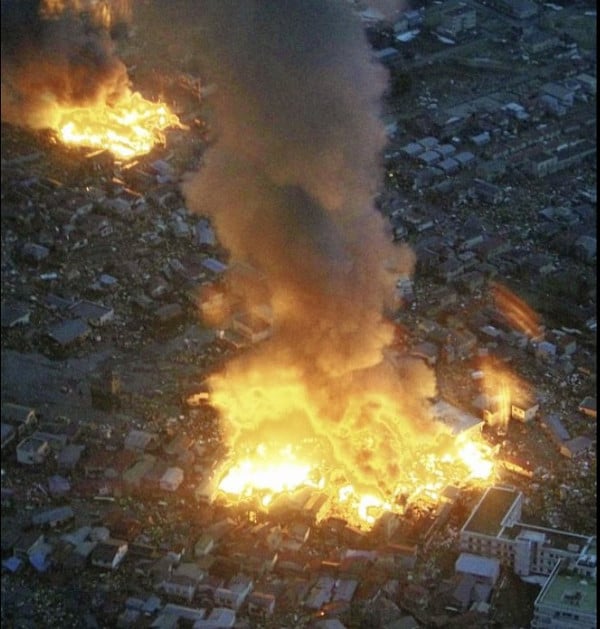
Strong inertial forces can damage fire protection systems—leaving buildings vulnerable to fire after earthquakes
As a building moves during an earthquake, strong inertial forces threaten the nonstructural components that perform core functions on a property like fire sprinkler, electrical, plumbing, and HVAC systems. These forces can cause system parts to shake and sway violently, sustaining damage and potentially falling.
Fire sprinkler systems are particularly vulnerable to damage from shaking. Besides direct damage to pipes—a major concern—shaking during an earthquake puts significant stress on pipe hangers.
Between the cost of parts, labor, and damage caused by gushing water, building owners can face considerable expense getting sprinklers back online and cleaning up the aftermath of a flood. Water damage alone is estimated at up to $1,000 for every minute a single sprinkler dumps water—and a pipe break can be a lot worse.
But it’s the serious risk to life safety after an earthquake that’s most alarming if fire sprinklers fail. Fire codes may render buildings with damaged sprinkler systems unfit for normal use—even if the building sustains no structural damage and the mechanical, plumbing, gas, and electrical systems are working. Implementing a fire watch could keep the building operational, but the manpower requirements are often cumbersome and costly.
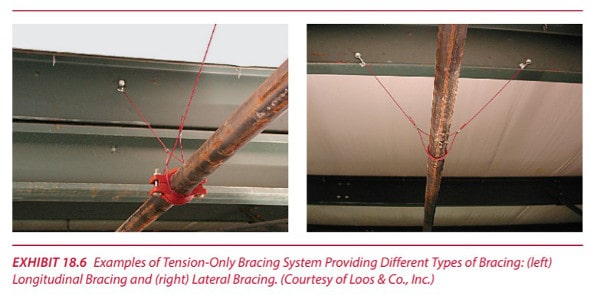
Seismic bracing stops nonstructural components from shaking and swaying
Fortunately, there’s a simple fix for avoiding the earthquake damage that’s caused by inertial force: rigidity. In other words, the best way to prevent nonstructural components from shaking and swaying relative to the building is by firmly attaching them to structural elements like ceilings and beams. This way, both structural and non-structural elements will move as a unit during a quake.
Let’s break down exactly what that means. Fire sprinkler risers, main lines, and branch lines are normally hung or otherwise secured to structural components of a building in several ways, including:
- Hanger rods
- Anchors driven into steel, concrete, or wood that are then threaded to accept hanger rods
- Riser clamps that support risers
- Top-beam clamps that attach a pipe to structural steel beams without drilling, and are then threaded to accept hanger rods
- Pipe hanger rings that support pipes
Seismic bracing, or sway bracing, is designed to prevent excessive movement of system piping, which can cause the pull-out or fracture of these components. A pipe suspended from the ceiling, for instance, receives extra support so that it always moves as a unit with the ceiling during an earthquake. Of course, the 2019 edition of NFPA 13: Standard for the Installation of Sprinkler Systems (18.5.1.2) emphasizes that these structural elements must be carefully selected to ensure their ability to withstand possible seismic forces.
Seismic bracing resists horizontal motion, meaning braces prevent both lateral (perpendicular to the pipe) and longitudinal (parallel to the pipe) swaying. Vertical motion isn’t typically a concern, as gravity will usually offset vertical lift forces, and vertical downward forces should be handled within the normal safety factors of system hangers.
Model building and fire codes mandate seismic safeguards for nonstructural elements when buildings fall into a certain seismic design category. The American Society of Civil Engineers (ASCE) is the leading authority in this area. Its model code, ASCE 7: Minimum Design Loads for Buildings and Other Structures, informs the specific earthquake-protection applications for fire sprinkler systems detailed in the 2019 edition of NFPA 13.
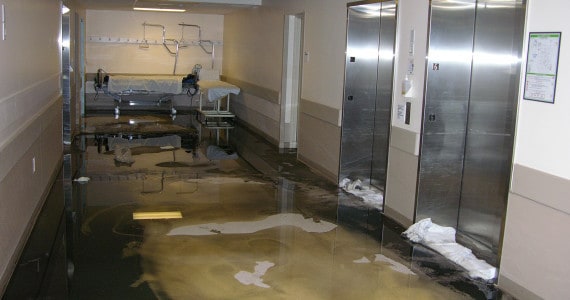
To learn more about the principles of seismic bracing and NFPA requirements, check out our previous blog, “Seismic Design for Fire Sprinklers, Part 2: Seismic Bracing.” But essentially, Section 18.5 of NFPA 13 requires seismic bracing to secure:
- The top of system risers
- All feed and cross mains and other piping, regardless of size
- Branch lines 2.5 inches (65mm) in diameter or larger require lateral bracing only. Branch line piping 2 inches (50mm) in diameter or smaller is generally more flexible and only requires vertical restraint, not bracing.
To learn whether seismic design is needed in your building, read our previous blog: “Seismic Design for Fire Sprinkler Pipes, Part 1: Flexible Design.”
That blog also addresses how the seismic design principle of flexibility – via flexible couplings, seismic separation assemblies, or simple clearance – works beside seismic bracing to counter the other major source of damage during an earthquake: differential movement. Differential movement occurs when buildings (or different parts of one building) move differently, causing pipes to separate, bend, twist, slam, or otherwise sustain damage.

Loos seismic bracing satisfies the seismic design requirements of model codes for nearly all nonstructural systems
Loos seismic bracing cable protects the infrastructure of prominent buildings worldwide, from the 9/11 Memorial and Hearst Tower in Manhattan to the NASCAR Hall of Fame and Pitt-Greenville Airport in North Carolina. Its pre-stretched, color-coded, break-strength-certified seismic bracing cable is UL (formerly known as Underwriters Laboratories), Intertek, and ICC-ES (International Code Council Evaluation Service) listed for use in fire sprinkler systems.
It not only satisfies the requirements of NFPA 13 for all pipe sizes, but it’s pre-engineered to satisfy the earthquake bracing requirements of national model codes and standards for nearly all nonstructural building components and systems. That includes the International Building Code (IBC), ASCE 7, and ASCE 19: Structural Applications of Steel Cables for Buildings. Loos seismic bracing cable is also listed in the FBC System Compatibility Program, making it compatible with fire sprinkler systems containing Lubrizol CPVC pipe.
Applications include such systems and components as:
- Mechanical
- Electrical
- Telecommunications
- Fire protection
- HVAC equipment
- Ductwork
- Electrical cable trays
- Pneumatic tubing
- Architectural features
- Suspended lighting systems
- Plumbing
- Floor- or roof-mounted equipment
- Trapeze-mounted overhead equipment
- Suspended equipment
- Furniture/file cabinets/shelving
- Lab and sensitive equipment
- Raised-access floors
Since 1958, the Naples, FL-based Loos & Co. has stood out as a specialist in small-diameter wire ropes and aircraft cables, manufacturing wire rope, cable, and cable accessories. Its cable and cable assemblies secure critical flight control and mechanical control systems on commercial and military aircraft manufactured by Lockheed, Airbus, Boeing, Bombardier, and more. Its products also help ensure the safety of U.S. government military equipment and NASA flight systems, as well as commercial lifting and rigging applications where connections and strength ratings cannot fail.
In 1993, Loos applied its technology and experience to the seismic bracing industry. The demands of increasingly stringent building code compliance—combined with the need for new, innovative, and cost-saving building components—spurred the development of the Loos seismic bracing cable system.
Want to learn more about Loos seismic bracing cable? Watch this video to dig deeper into how it can keep building systems safe from earthquakes:
Loos seismic bracing cable: here’s how it works
Manufactured from galvanized aircraft cable, Loos seismic bracing assemblies act in tension, immobilizing a braced item by pulling on it from opposite sides. The two cables required at each brace location are firmly attached to a structural component in the building, causing the braced item to move with the structure during a seismic event. This simple technology helps a building’s essential systems resist damage caused by inertial forces and remain operational after the earthquake ends.
Section 18.5.4.2 of NFPA 13 states that tension-only braces are permitted when they’re listed for the purpose and the seismic loads do not exceed their listed capabilities. To ensure the effectiveness of a sway brace system, installers need to determine the horizontal seismic load it needs to resist at a given location. Horizontal seismic load is the force parallel to the ground that a fire sprinkler or other nonstructural system may experience as it shakes during an earthquake.
Loos seismic bracing cables come in 250’ spools for custom job site applications, featuring load ratings ranging from about 418 to more than 3,000 pounds. Cables are color-coded to simplify the identification of different sizes and load strengths in the field. Gold cable, with a load rating of 418 pounds, is the most popular size and can be used across many applications.
Model codes offer complex explanations for determining seismic load, but Loos & Co. customers can take advantage of a free, web-based, user-friendly design calculator that quickly completes the calculations required to create code-compliant seismic bracing designs.
The Engineers’ Tools Seismic Calculator prompts users to enter details of an installation from building blueprints. It will then process NFPA 13 seismic calculations for the design—noting if anything is incorrect—and produce a completed NFPA 13 form to submit to the authority having jurisdiction (AHJ).
If project conditions change, the calculator allows users to easily edit their design. It can even produce a bill of materials that you can email to QRFS for easy quoting.
Of course, final accountability for approving specific designs, code interpretations, and/or installations rests with the engineer responsible for the specific design and/or the AHJ.
For more code information, read our article NFPA 13 Seismic Bracing Requirements: Cable Sway Braces.
Why swaged end fittings matter to seismic design and how to best achieve them
Loos engineers understand the capabilities of small-diameter wire rope. The company’s seismic bracing systems are designed with swaged end, or permanent, connections and fittings. These zinc-plated oval sleeves are easily installed in the field by hand with Loos crimping tools. Easy-to-follow instructions are included with every installation tool. The oval sleeves are zinc-plated to maximize corrosion resistance.
Loos’ permanent end sleeves do not damage the cable and, when properly applied, have a rated holding power that meets or exceeds the breaking strength of the wire rope itself. They enable a seismic bracing system to rely on smaller cables to carry the seismic loads it could experience, avoiding the “overkill” of using larger cables that often rely on inefficient, hand-tightened mechanical or locking-type fittings.
IBC requires swaged end fittings for seismic bracing per ASCE 19. ASCE 19 does not permit common wedge or clip-type fittings for seismic installations because they may loosen over time, risking damage to the cable and assembly strength.
To achieve proper swaging of seismic bracing cable, an installer must:
- Use the correct swaging tool to maintain strength.
- Select the proper sleeve size for the corresponding cable size.
- Swage the duplex oval sleeve in the proper cavity of the swaging tool with the required number of sleeve compressions.
- Gauge the compressed sleeve to measure the after-swage diameter of the compressed sleeve.
Now read this carefully: proper performance and cable that meets UL standards are not guaranteed for installers who don’t use the proper Loos tools. Cables that become crushed or deformed when cut are difficult to use with fittings. The unique triangular cutting jaws of Loos tools are carefully designed to cut cleanly and avoid frayed ends, allowing easy splicing and insertion into sleeves.
This video demonstrates using a swaging tool:
Why Loos seismic bracing cable is the best choice for retrofits
Aside from cables, rigid seismic bracing can also be used to secure nonstructural system components in a building. As its name states, rigid bracing is a stiff, unbending piece of equipment that’s almost always made of steel. Its biggest selling point is that it resists motion in two ways, utilizing compression and tension to protect against inertial forces. Thus, two cable braces are needed to do the same job as a single rigid brace.
But this advantage also creates a bigger disadvantage: a rigid length of steel has to be cut to the proper length to run from the structural anchor point to its attachment at the pipes. Cutting steel is a challenging, time-consuming task. And because it relies on compression as well as tension, rigid braces are limited by ratios that determine the maximum length that can be used before buckling.
In contrast, Loos seismic bracing cable has basically no length limitations. The small-diameter cable is flexible and can be easily cut to fit any space—meaning that cable of any length can be installed to brace components at many different locations. With little more effort needed than hand-tensioning to complete installation, Loos seismic bracing installs in half the time of rigid braces.
The tight spaces involved in many retrofits are also rarely a problem for installing cable bracing, which offers the versatility needed to create angles of 30° to 90° (measured from vertical) from the braced component.
It’s important to keep in mind that the maximum horizontal load varies with the brace angle; a totally vertical brace assembly sustains the same amount of torque as a pipe hanger assembly. The further from vertical the brace can be angled, the more horizontal force it and its hardware can sustain.
Manufacturers’ datasheets state the maximum allowable loads at angles other than horizontal (90° from vertical), but Table 18.5.2.3 in NFPA 13 also describes how to calculate the load at an angle:
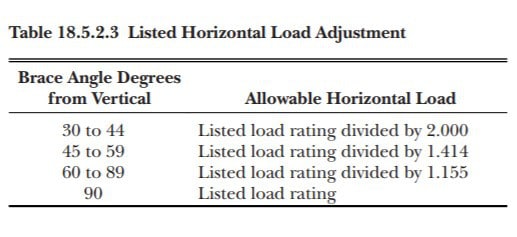
The easier installation of seismic bracing cable offers a distinct advantage amidst today’s ever-evolving seismic bracing codes and retroactive enforcement policies. Besides the need for easy-to-use, code-compliant bracing in new projects, many properties must undergo retrofits to become code compliant, and existing installations of plumbing, electrical cable trays, and HVAC and other mechanical systems leave little room to work seismic bracing components into fire sprinkler applications.
With a flexible design and easy installation in tight, difficult spaces where other equipment is already installed, Loos seismic bracing cable stands as the best choice for successful retrofit projects.
Three simple ways to install Loos seismic bracing for pipes
Why are Loos installations so simple? Let’s examine the three main ways for installing seismic bracing cable to support nonstructural components like fire sprinklers:
How to install Loos seismic bracing using a lateral brace
The 2019 edition of NFPA 13 (18.5.5.1) requires lateral sway bracing on all feed and cross mains regardless of size, and all branch lines and other piping with a diameter of 2.5 inches (65 mm) and larger.
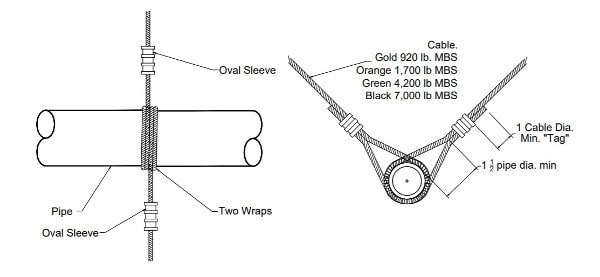
- Determine the best method of securing the cable to the structure. Refer to the design specifications from the Loos Seismic Design Calculator or Seismic Design Guide. Methods may include securing the cable around a steel beam and then swaging an oval sleeve, or using a Loos anchoring fitting secured to the structure with a bolt or screw and then adding a swaged loop. Fittings, bolts, and screws must be listed and approved for the seismic load. Fittings are listed for the color of cable they accept without reducing breaking strength.
- Bracing cable is threaded through the attachment holes on the anchor. A sleeve that fits over the ends of the cable—after crimping it with a hand swager (gauged for different colors of cable)—holds it in place.
- Slide another oval sleeve onto the end of the cable. Slide the sleeve up the cable to allow room to work.
- Align the cable so that it is perpendicular to the pipe. Wrap the cable around the pipe twice. Form a simple knot on the second wrap to hold the cable in place.
- Slide the loose end of the cable into the sleeve and pull the cable to remove any slack between the brace and the structure. Be careful not to pull so tight that excessive force is applied to the pipe.
- Before you swage the sleeve, make sure it rests a minimum distance of about 1.5 pipe diameters away from the pipe to ensure that a minimum angle of 45° in the cable is maintained.
- Crimp the sleeve with the required number of compressions per Figure 1 below.
- Cut any cable extending beyond the sleeve.
- Repeat in the opposite direction.
- Cut any cable extending beyond the sleeve.
- Repeat in the opposite direction.
Watch this video to see an installation of Loos seismic bracing with a lateral brace:
How to install Loos seismic bracing using a longitudinal brace
NFPA 13 (18.5.6.1) requires longitudinal sway bracing spaced at a maximum of 80’ (24 m) on center for feed and cross mains. Section 18.5.6.2 states that longitudinal braces shall be allowed to act as lateral braces if they are within 24” (600 mm) of the centerline of piping braced laterally.
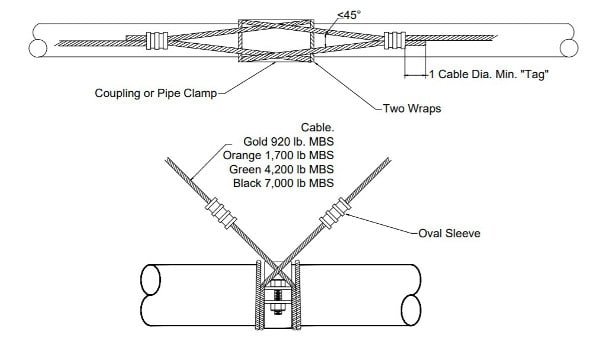
- Determine the best method of securing the cable to the structure. Refer to the design specifications from the Loos Seismic Design Calculator or Seismic Design Guide. Methods may include securing the cable around a steel beam and then swaging an oval sleeve, or using a Loos anchoring fitting secured to the structure with a bolt or screw and then adding a swaged loop. Fittings, bolts, and screws must be listed and approved for the seismic load. Fittings are listed for the color of cable they accept without reducing breaking strength.
- Bracing cable is threaded through the attachment holes on the anchor. A sleeve that fits over the ends of the cable—after crimping it with a hand swager (gauged for different colors of cable)—holds it in place.
- Align the cable parallel to the pipe. Slide another oval sleeve onto the end of the cable. Slide the sleeve up the cable to allow working room.
- Wrap the cable around the pipe twice. Form a simple knot on the second wrap to hold the cable in place. Be sure the wrap is on the far side of a pipe clamp or grooved coupling, and not on it.
- Slide the loose end of the cable into the sleeve and pull the cable to remove slack. Don’t pull so tight that excessive force is applied to the pipe.
- Before you swage the fitting, ensure the pipe sleeve is situated at least 1.5 diameters from the pipe to ensure the maximum 45° angle in the cable is maintained.
- Crimp the sleeve with the right number of compressions per Figure 1 above.
- Cut any cable extending beyond the sleeve.
- Repeat in the opposite direction.
Watch this video to see an installation of Loos seismic bracing with a longitudinal brace:
How to install Loos seismic bracing using a 4-way brace
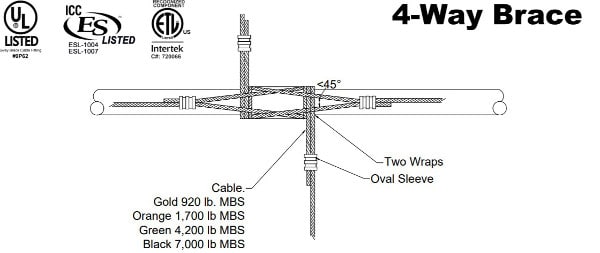
A 4-way brace is a lateral brace and a longitudinal brace applied to a pipe at a coupling, pipe clamp, or tee fitting. Simply follow the steps above for the lateral brace, and then follow the steps for a longitudinal brace. NFPA 13 (18.5.8.1) also requires 4-way braces at the tops of risers exceeding 3’ (900 mm) in length. 4-way braces are not required for risers up to 7’ (2.1 m) in length that terminate above the roof assembly or top landing (18.5.8.1.1).
Watch this video for more information about installing Loos seismic bracing with a 4-way brace:
Loos seismic bracing cable can keep earthquake damage from threatening life safety
Without proper seismic bracing, shaking can cause fire sprinklers to fail. Unfortunately, that timing couldn’t be worse, as the risk of fire is significantly higher than normal after an earthquake. Loos seismic bracing cable is specifically engineered to minimize earthquake damage to fire sprinklers and nearly all overhead, nonstructural building components—cost-effectively satisfying codes and standards and keeping people and property safe.
If you’re earthquake-proofing your fire sprinkler system, QRFS can outfit you with key seismic design components. We carry Loos seismic bracing cable, seismic bracing anchors, and the swagers and cable cutters you need to install seismic bracing.
We also have flexible sprinkler drop assemblies to give your system the flex it needs in the right places – and grooved flexible couplings that are available by special order. Simply call us at +1 (888) 361-6662 or email us at support@qrfs.com.
This blog was originally posted at blog.qrfs.com. Check us out at Facebook.com/QuickResponseFireSupply or on Twitter @QuickResponseFS.



This is a great read. When building a structure, safety for the stakeholders is the top priority. Thank you for giving emphases on the benefits of using seismic bracing.
This is an explosive idea; this is most probably the best and most successful thing that I have read on this topic about seismic bracing… I love this blog and really happy to come across this exceptionally well written content. Thanks for sharing!! Come across Bvtengineering.com and hope you can visit this too to get more information.